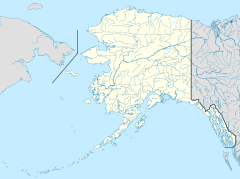Georgetown, Alaska facts for kids
Quick facts for kids
Georgetown
|
|
|---|---|
|
Unincorporated community village
|
|
| Country | United States |
| State | Alaska |
| Census area | Bethel |
| Population
(2010)
|
|
| • Total | 2 |
| Time zone | UTC-9 (Alaska (AKST)) |
| • Summer (DST) | UTC-8 (AKDT) |
Georgetown is a small, unincorporated village in Alaska. This means it's a community that isn't officially part of a city or town government. It is an Alaska Native village located in the Bethel Census Area.
In 2010, only two people lived in Georgetown. This number was a little lower than in 2000, when three people lived there.
Contents
Where is Georgetown Located?
Georgetown is found at 61°53′N 157°42′W / 61.883°N 157.700°W in the Kilbuck-Kuskokwim mountains. It sits on the north bank of the upper Kuskokwim River. The village is about 16 miles (26 km) downstream from Red Devil. It is also just upstream from where the George River flows into the Kuskokwim River.
You can reach Georgetown in a few ways. People travel there by boat, by snowmobile in the winter, or by small airplane.
A Look at Georgetown's Past
Early Explorers and Native Life
People who were not Native first explored this part of the Kuskokwim River in the mid-1800s. A Russian naval officer named Lt. Lavrenty Zagoskin explored the area in 1844. At that time, the village was known by its Native name, Keledzhichagat. It was used as a summer fishing spot by people from Kwigiumpainukamiut.
Gold Rush and Growth
In 1909, gold was found further up the George River. Because of this discovery, a mining settlement quickly grew. This new settlement was built on the bank of the Kuskokwim River. It was just west of where the George River meets the Kuskokwim.
The settlement and the river were named after three traders. Their names were George Hoffman, George Fredericks, and George Morgan. By 1910, Georgetown's population grew to about 300 people. There were around 200 homes because of all the mining activity.
Fire and New Beginnings
A big fire swept through the town in 1911. Most of the buildings were destroyed. By 1953, only one large building remained at the original site. This was a two-story log house that belonged to George Fredericks.
Later, a second settlement started to grow east of the George River. This new place was also called Georgetown. A state school was opened there in 1965. As mining became less popular, people started to leave the area. The school eventually closed in 1970.
Land Ownership and Tribal Council
The Alaska Native Claims Settlement Act was passed in 1971. This law gave the descendants of the town's original people a chance to own the land. Because of this, the Native Village of Georgetown was officially created. As of June 1, 2009, the Georgetown Tribal Council had 128 members. Most of the original members and their families still live nearby.
Population Changes Over Time
| Historical population | |||
|---|---|---|---|
| Census | Pop. | %± | |
| 1980 | 6 | — | |
| 1990 | 0 | −100.0% | |
| 2000 | 3 | — | |
| 2010 | 2 | −33.3% | |
| U.S. Decennial Census | |||
Georgetown first appeared in the U.S. Census in 1980. At that time, it was listed as an unincorporated Native village with 6 residents. In 1990, it was given a special title: Alaskan Native Village Statistical Area (ANVSA). However, no residents were reported in the census that year. In 2000, 3 people lived there, and in 2010, the population was 2.
See Also
 In Spanish: Georgetown (Alaska) para niños
In Spanish: Georgetown (Alaska) para niños


